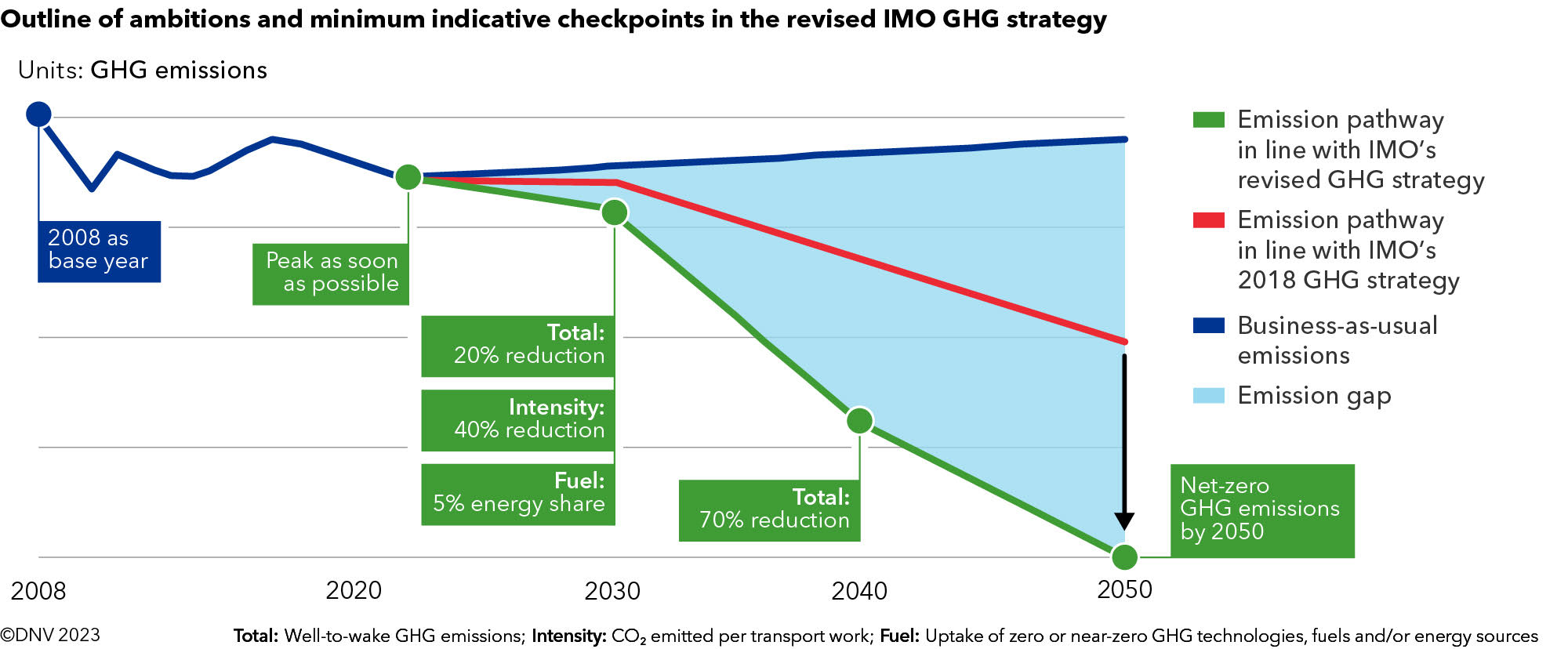The 2020’s is proving to be the decisive decade for the decarbonization of shipping. Regulations from key bodies like the IMO and EU are taking shape, driving industry stakeholders to implement plans now which will influence the direction of decarbonization efforts in the coming decades. This year’s Maritime Forecast to 2050 continues to examine the impact of the latest regulatory decisions from the EU and IMO while also providing an overview of how an eco-system for carbon-neutral fuels can develop. The report takes a deep dive into selected technologies that can drive greater energy efficiency in the maritime industry and help to alleviate the demand for carbon-neutral fuels in the coming decades.
IMO’s revised GHG strategy
In July 2023, the IMO completed the first revision of its greenhouse gas (GHG) strategy, significantly strengthening the ambitions for international shipping compared with the initial goal for a 50% GHG reduction by 2050. Taking 2008 as a baseline, the revised strategy now aims to reduce well-to-wake GHG emissions by 20% in 2030, by 70% in 2040, and to reach net-zero ‘by or around’ 2050.
The GHG Strategy now also addresses lifecycle GHG emissions from shipping, with the overall objective of reducing GHG emissions within the boundaries of the energy system of international shipping and preventing a shift of emissions to other sectors.
Global fuel production database
Achieving decarbonization goals requires a large-scale transition to new fuels, which is already underway, and this year’s Maritime Forecast to 2050 presents a new and comprehensive global fuel production project database. The stats reveal that shipping would need 30–40% of the estimated global supply of carbon-neutral fuels if it is to meet expected demand of 17 Mtoe per year by 2030, taking into account the IMO’s current GHG strategy.
Alternative decarbonization solutions
Although the maritime industry should continue to prepare for the transition to carbon-neutral fuels, the Maritime Forecast to 2050 recommends several energy efficiency measures which can deliver decarbonization results now, while also contributing to reductions in demand and price pressure in the future. In the short-term the report focuses on how shipping can evolve from easy, low-cost options like speed reduction and route optimization, to increasingly digitalized systems, and energy saving technologies like wind assisted propulsion and air lubrication systems.
Onboard carbon capture and storage (CCS) and nuclear propulsion have been identified as potentially important medium to long-term solutions as increased use of both technologies could contribute to GHG reductions while also reducing competition for carbon-neutral fuels. This year the Maritime Forecast to 2050 presents an economic analysis of both options through detailed case studies which will help stakeholders make informed decisions around these technologies.
An integrated approach for decarbonization
The maritime industry needs to adopt an integrated approach which ensures the strong evolution of regulations and technologies, and the long-term security of fuel supply. Individual shipowners should consider all available decarbonization options and focus on fuel flexibility and reduced energy consumption, while also considering a long-term fuel strategy. The Maritime Forecast to 2050 outlines how the maritime industry should continue to collaborate with fuel suppliers and other stakeholders from an early stage so that clarity over demand can be established, paving the way for final investment decisions across the value chain, both onboard and onshore.
The 2020’s is a decisive decade for shipping and the quality and effectiveness of plans put in place now will dictate how successful the maritime industry is in reaching its decarbonization goals over the coming decades.
Figure 3–2 Outline of ambitions and minimum indicative checkpoints in the revised IMO GHG strategy
© DNV 2023
Quelle & Kontakt:

